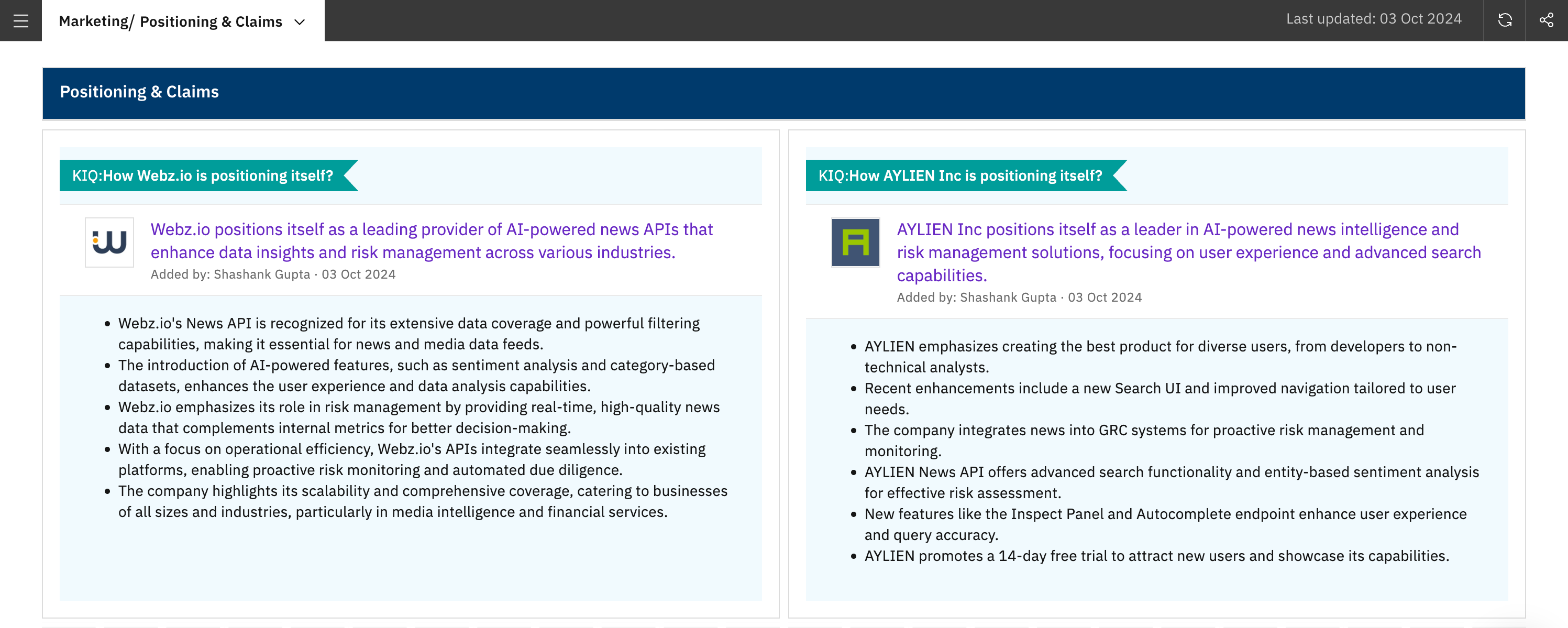What is Competitive Positioning?
Basically, competitive positioning is how a company differentiates it’s products or services from its competitors’ in the minds of the customers. Competitive positioning in marketing is about deliberately highlighting unique differentiations to help customers understand why they should choose you over competitors.
According to April Dunford, “Positioning defines how your product is a leader at delivering something that a well-defined set of customers cares a lot about.”
In the above definition, “delivering something” is your value proposition, and “well-defined set of customers” is your target market segment.
What is competitive positioning strategy? It is all about identifying your target customers’ unmet needs and mapping them to your company’s core strengths. If you are unable to identify such needs, you should consider reviewing your target customers.
Types of competitive positioning include choosing to differentiate through price, product or service quality, superior customer service, innovation, or customization, whatever is important for your target customers and not offered by competitors.
Importance of Competitive Positioning
One of the greatest benefits of competitive positioning is this process infuses your organization with purpose and direction, guiding not only your marketing strategy but your entire business strategy.
- This clarity helps keep your team members focused and strategically aligned with the organization’s goals.
- It improves internal alignment, coordination, and communication, leading to more efficient and effective teamwork.
- In an over-communicated society, having a clear competitive positioning increases the chances that your messages get heard and recognized.
Having a clear competitive position in business further increases the chances that your messages get heard and recognized. It plays a central role in attracting and retaining customers. By embracing strengths-based positioning, you can create a “barrier to entry” for competitors. This is achieved by strengthening those aspects, systems, and processes that are the sources of your competitive differentiation.
How to Develop Effective Competitive Positioning
To develop effective competitive positioning, you must start by understanding your target customers’ unmet needs. Customers always have these needs because they are constantly trying to improve by seeking better or more cost-effective solutions.
Why constantly? Because your customers’ competitors are also continuously trying to improve. That’s the nature of capitalism. And if your customers don’t improve continuously, they will lose to their competitors.
These unmet needs from the customers’ perspective must be considered while defining your value proposition for competitive positioning. By aligning these needs with your organization’s core strengths, you can address the gaps to compete better with your competitors.
This step is crucial before developing your competitive positioning as the leader in the minds of your customers.
Irrespective of your target segment, one thing is certain in the B2B domain: all customers research and evaluate different products before making a purchase decision. During this process, they develop a perception of your products and services available to address their unmet needs compared to your competitors’ products.
Their experiences with your products influence their expectations and develop a frame of reference. Your target customers’ frame of reference defines your competitive landscape, making mapping your competitive position a critical step in your go-to-market efforts.
This frame of reference is shaped by the information available on your competitors, such as press announcements, business news coverage, customer reviews, and marketing content, such as white papers, blogs, webinars, social posts, etc. Therefore, understanding your competitors positioning is essential before defining your differentiated positioning in the competitive landscape.
By closely monitoring your competitors, you gain insights into the information they share and how they position themselves in the minds of customers. This forms the foundation of competitive position analysis and supports the creation of a robust competitive positioning framework.
Role of Competitive Intelligence in Developing Your Positioning
Competitive intelligence is the ongoing process of gathering and analyzing information on competitors. Why is it an ongoing process?
Because, unlike the vision and mission of a company, competitive positioning is not static. It is a dynamic process and evolves with the organization’s next milestones. Let’s understand with the example of IBM.
IBM started as a hardware company. With the shift in the market and the growth in software and services, IBM transitioned its positioning strategy from a machine-centric company to a solutions provider to meet the customer’s changing needs.
Over time their competitive positioning model has evolved and today they position themselves as a leader in cloud computing, artificial intelligence, and other cutting-edge technologies. Their focus has moved beyond offering solutions to empowering businesses through digital transformation.
To stay relevant to the changing landscape and customers’ evolving needs, IBM continued to study its market and competitors. Incorporating these insights into its business strategies helped it evolve with the changes and stay relevant in the dynamic market landscape.
Companies need comprehensive competitive positioning tactics to capture relevant information and structure information about competitors. This information helps to identify gaps in the market, monitor competitors’ positioning, and what customers perceive of their brand. It also helps to create a competitive positioning roadmap to map strengths and align them with the unmet needs of the customer, capturing the attention of prospective customers by highlighting key differentiators.
Ongoing competitive intelligence-based positioning practices ensure that your positioning is responsive to market dynamics, helping your organization stand out in a crowded marketplace.
Select the Right Tool for Competitive Intelligence
In a world filled to the brim with information overload, automation is the way to conduct comprehensive research on what your competitor is doing without missing critical updates. The right competitive positioning analysis tool will provide:
- Mapping your competitive position using real-time data and structured insights
- Access to a worldwide net of content sources that are reliable, accurate, and relevant
- Convenience to find relevant insights easily without reading long articles
- Seamless process to communicate insights across different business functions
Contify M&CI platform is the automation engine you can trust to track competitors’ movements and anticipate their next strategic direction.
How can Contify’s Platform be your single source of truth?
Comprehensive Information Sourcing of Competitors: The Contify platform provides access to 1Mn+ vetted content sources including company websites, press releases, regulatory portals, and industry publications. A continuous competitive position monitoring mechanism ensures you’re always aware of your competitors’ moves. This helps to understand their brand positioning, evaluate your current strategy, identify and strengthen your value propositions, and uncover need gaps in the market; a vital part of any competitive positioning framework.
Smart Filters to Reduce Noise: Its custom taxonomies help to access curated information in a structured and noise-free manner. You can filter your competitor’s information based on topics like new offerings, emerging tech, operational challenges, mergers and acquisitions, partnerships, etc., all of which help you conduct deeper competitive positioning analysis.
Automated Answers to Key Intelligence Questions: The Contify platform also features an Insight module, which further simplifies information consumption. Powered by a unique combination of large language models (LLMs) and Knowledge Graphs, the Insights module helps you find answers to ad-hoc querie, and supports your competitive positioning in marketing.
For instance, you can ask questions like “How is [competitor] positioning itself?” and receive relevant answers that help you assess their competitive positioning tactics and messaging.
This significantly reduces the time needed to sift through data to find critical competitor positioning insights.
Here is an example of how Contify’s marketing team uses the Insights module to efficiently analyze the positioning of our competitors and craft differentiating positioning for our products.

The above image includes how two of our News API competitors position themselves. Webz.io positions itself as a provider of AI-powered news APIs that enhance data insights and risk management, and key messaging focuses on extensive data coverage, powerful filtering capabilities, and operational efficiency.
Aylien, on the other hand, positions itself as an AI-powered news intelligence and risk management solution, and key messaging focuses on user experience, advanced search capabilities, and free trial availability.
Both are clear competitive positioning examples with unique differentiators. By studying these players, we are able to map our competitive position, develop our value proposition, and identify the types of competitive positioning that resonate best with our audience.
Some more capabilities of Contify that help it become your single source of truth includes:
Automated visualization of strategic information: The platform has auto-updating widgets that automate the creation of strategic graphs and charts to benchmark competitors or understand their product timelines. This visual layer helps in mapping competitive position over time and supports strategy planning.
Seamless information dissemination across teams: It also ensures smooth information delivery across various business functions with automated newsletters and alerts. Integrations with other communication platforms, such as Slack, MS Teams, and CRMs, are also available. This boosts alignment and keeps teams updated on your competitive positioning meaning in a dynamic environment.
Take a free trial of Contify’s Market and Competitive Intelligence Platform.
Conclusion
Today’s competitive landscape is evolving continuously and strategies built on incomplete data are irrelevant. Past strategies that may have worked before will not work with the changing dynamics. Your strategies should be aligned with the ever-evolving market and competitive landscape.
B2B competitive positioning helps businesses stay informed about their competitors and gives a clear understanding of their competitive positioning meaning in the current context. Using specific insights into your competitor’s positioning helps you to distinctly position your brand in the minds and hearts of your potential customers.
By continuously monitoring your competitors, you will remain updated with their movements and make strategic changes in your marketing messaging. It will help you stand out and address the value gaps in the minds of your potential customers.
A comprehensive market and competitive intelligence platform like Contify can help you stay on top of all competitor updates.
FAQs
1. What is competitive positioning in marketing?
Competitive positioning in marketing refers to how a company differentiates its product or service in the minds of its target customers relative to competitors, based on value, quality, innovation, or service.
2. Why is competitive positioning important for B2B companies?
B2B companies rely on competitive positioning to clearly communicate their unique value proposition, build trust with stakeholders, and stand out in a complex, solution-driven market.
3. What are the main types of competitive positioning strategies?
The main types include cost leadership, differentiation, niche focus, innovation, and customer intimacy—each aiming to address specific customer needs better than competitors.
4. How can businesses monitor their competitive position?
Businesses can monitor their competitive position by tracking competitor activity, customer feedback, pricing changes, and market trends. Platforms like Contify automate this process by collecting, curating, and delivering real-time intelligence on competitors across sources, making it easier to stay ahead.



